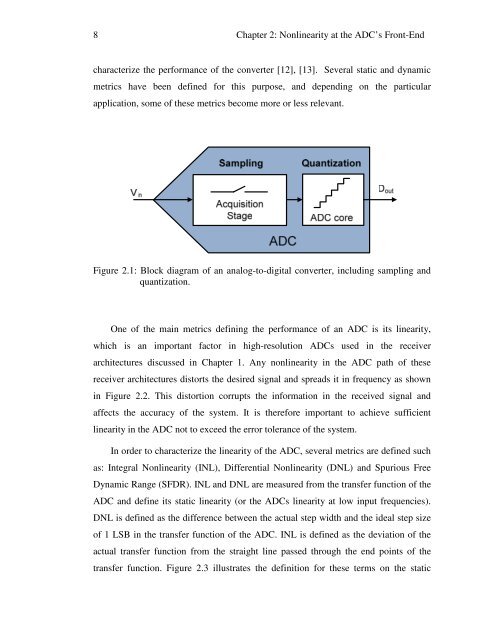digital compensation of dynamic acquisition errors at the front-end of ...
digital compensation of dynamic acquisition errors at the front-end of ...
digital compensation of dynamic acquisition errors at the front-end of ...
You also want an ePaper? Increase the reach of your titles
YUMPU automatically turns print PDFs into web optimized ePapers that Google loves.
8 Chapter 2: Nonlinearity <strong>at</strong> <strong>the</strong> ADC’s Front-End<br />
characterize <strong>the</strong> performance <strong>of</strong> <strong>the</strong> converter [12], [13]. Several st<strong>at</strong>ic and <strong>dynamic</strong><br />
metrics have been defined for this purpose, and dep<strong>end</strong>ing on <strong>the</strong> particular<br />
applic<strong>at</strong>ion, some <strong>of</strong> <strong>the</strong>se metrics become more or less relevant.<br />
Figure 2.1: Block diagram <strong>of</strong> an analog-to-<strong>digital</strong> converter, including sampling and<br />
quantiz<strong>at</strong>ion.<br />
One <strong>of</strong> <strong>the</strong> main metrics defining <strong>the</strong> performance <strong>of</strong> an ADC is its linearity,<br />
which is an important factor in high-resolution ADCs used in <strong>the</strong> receiver<br />
architectures discussed in Chapter 1. Any nonlinearity in <strong>the</strong> ADC p<strong>at</strong>h <strong>of</strong> <strong>the</strong>se<br />
receiver architectures distorts <strong>the</strong> desired signal and spreads it in frequency as shown<br />
in Figure 2.2. This distortion corrupts <strong>the</strong> inform<strong>at</strong>ion in <strong>the</strong> received signal and<br />
affects <strong>the</strong> accuracy <strong>of</strong> <strong>the</strong> system. It is <strong>the</strong>refore important to achieve sufficient<br />
linearity in <strong>the</strong> ADC not to exceed <strong>the</strong> error tolerance <strong>of</strong> <strong>the</strong> system.<br />
In order to characterize <strong>the</strong> linearity <strong>of</strong> <strong>the</strong> ADC, several metrics are defined such<br />
as: Integral Nonlinearity (INL), Differential Nonlinearity (DNL) and Spurious Free<br />
Dynamic Range (SFDR). INL and DNL are measured from <strong>the</strong> transfer function <strong>of</strong> <strong>the</strong><br />
ADC and define its st<strong>at</strong>ic linearity (or <strong>the</strong> ADCs linearity <strong>at</strong> low input frequencies).<br />
DNL is defined as <strong>the</strong> difference between <strong>the</strong> actual step width and <strong>the</strong> ideal step size<br />
<strong>of</strong> 1 LSB in <strong>the</strong> transfer function <strong>of</strong> <strong>the</strong> ADC. INL is defined as <strong>the</strong> devi<strong>at</strong>ion <strong>of</strong> <strong>the</strong><br />
actual transfer function from <strong>the</strong> straight line passed through <strong>the</strong> <strong>end</strong> points <strong>of</strong> <strong>the</strong><br />
transfer function. Figure 2.3 illustr<strong>at</strong>es <strong>the</strong> definition for <strong>the</strong>se terms on <strong>the</strong> st<strong>at</strong>ic
















